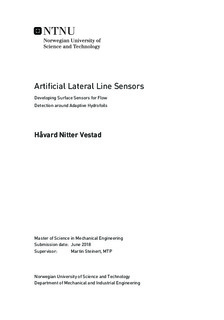| dc.description.abstract | In search for more efficient propulsion through water, many methods for improving on the existing hydrofoil and propeller designs we use today have been suggested, the topics of adaptive hydrofoils and propulsion systems is increasingly popular. A large portion of all world trade happens by sea, and even incremental improvements in propulsive efficiencies can have big economic and environmental impacts. Many researchers have looked to nature to find answers as to how to more efficiently use and manipulate water for propulsion and maneuvering.
In this master s thesis I investigate the mechanisms that enables fish to use flows actively, and efficiently, to improve the capabilities of adaptive hydrofoils through sensory inputs. The thesis is based on the work done in my pre-master s thesis into the effects of Kármán gaiting, where fish use alternating vortices shed from obstructions in flows to generate forward momentum and is a response to the limited capabilities I found in the field of high density, non-intrusive/flow-obstructive, flow sensing at the surface of bodies and hydrofoils, such that correct adaptive movements can be made.
I investigate different ways to sense flows along the skin of hydrofoils suspended in flowing water through prototyping and comparing solutions. Through comparison the piezo resistive effect of carbon fibers mixed with rubber silicone showed superior capabilities in detecting pressure changes as well as its ability to be easily imbedded and cast into flexible hydrofoils. The composite was further investigated in its capabilities in flow detection, through expanding the amount of datapoints with multiplexers to generate bigger pictures of the flow and enabling tendencies and pressure gradients to be seen. A water tunnel was run at different flow velocities of 0.04m/s and 0.1m/s, both free flowing and altered to generate alternating Kármán vortex streets. Two silicone hydrofoils were fitted with 64 sensors each. At 0.1m/s the Kármán flow generated cyclic behaviors in the forward-facing sensors in one of the hydrofoils, that directly corresponded with the observed and calculated shedding frequency. A dynamic neural network was further able to distinguish differences between all flow scenarios in separate data from the same calibrations and setups that were used in the training sets.
The carbon fiber rubber silicone sensor shows similar piezo resistive properties as the popular carbon nanocomposite-silicone sensors, but the ease of manufacturing and low cost of the carbon fiber sensor could open up new possibilities and implementation in areas where such carbon nanocomposite sensors have not yet been deployed. | |

